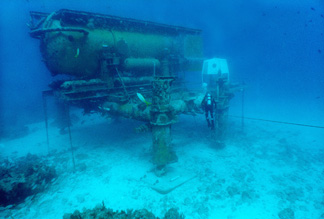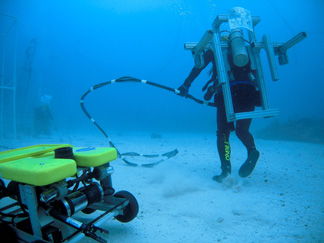|
Trends and Innovations
Astronauts Train Under the Sea
David Blaine did it for one week last spring. Some astronauts are doing it too, but for even longer: They are living underwater for three weeks at a time. But unlike Blaine, who was “drowned alive” — completely immersed in water — the astronauts have a fully enclosed habitat that serves as a good Earth analog for space conditions.
 The
mission of these underwater astronauts is to prepare for future work on
the International Space Station, the moon and eventually Mars. They are
spending days to weeks in Aquarius, the world’s
only undersea laboratory, located 5.6 kilometers off Key Largo in Florida.
The
mission of these underwater astronauts is to prepare for future work on
the International Space Station, the moon and eventually Mars. They are
spending days to weeks in Aquarius, the world’s
only undersea laboratory, located 5.6 kilometers off Key Largo in Florida.
Aquarius is the world’s only undersea habitat and laboratory, in which scientists and astronauts live and perform research. Image is courtesy of Andy Shepard/NOAA/NURP.
Training to build a space station on the moon requires an extreme environment, and the NEEMO missions offer the next-best thing to the moon’s low-gravity, harsh conditions. NEEMO, which stands for NASA Extreme Environment Mission Operations, is a joint collaboration between NASA, the National Oceanic and Atmospheric Administration (NOAA), which owns Aquarius, and the University of North Carolina in Wilmington, which operates the facility.
Aquarius, which has been in the waters off the Florida Keys since 1992, resembles a cross between an alien spaceship and a submarine, with a heavy steel body and porthole windows, and is about 3 meters wide by 13 meters long. Support systems pump air, freshwater and electricity into the habitat, says Otto Rutten, associate director of NOAA’s Undersea Research Center (NURC). It is about the same size as the space station, with similar amenities and limitations, which makes it a good training spot for astronauts.
The habitat rests on the seafloor about 19 meters (62 feet) below the surface. Aquanauts, as the underwater inhabitants are called, enter through a “wet porch” — a partially enclosed, nonpressurized area — to rinse off the saltwater and take off their wetsuits, Rutten says. The aquanauts then walk into the 37-square-meter (400-square-foot) living area and laboratory. The fully enclosed habitat is kept at the same pressure as the surrounding water pressure and stays around 70 degrees Fahrenheit, says Andy Shepard, director of NURC.
Within the living area is a bunk room with six “cozy” bunks, a toilet and a galley that holds a refrigerator and a microwave, Rutten says. The habitat also hosts a scientific laboratory, complete with telecommunications equipment. Aquarius is “a wonderful environment in which to live and very comfortable compared to past undersea habitats,” Shepard says.
Whatever the scientific mission, whether marine biology or lunar exploration, aquanauts work long hours. An average day involves getting up around 5:30 a.m. and working on the scientific projects all day, says Ron Garan, a NASA astronaut who participated in the ninth NEEMO mission. Other than being a little tired from the long working hours, aquanauts generally “feel the same as you do on solid ground, other than a little high due to mild nitrogen saturation in the blood,” Shepard says, “sort of a two-beer-buzz, we like to say.”
No short-term or long-term health effects come from living in Aquarius and the aquanauts do not experience seasickness, says Tim Broderick, a surgeon at the University of Cincinnati, and aquanaut on NEEMO 9, which occurred over 18 days in April. However, once divers are underwater for more than 70 minutes, they must decompress before returning to the surface, just like ordinary SCUBA divers who face decompression sickness, or “the bends” if they come up too quickly. The aquanauts, staying underwater more than 24 hours, must undergo a 17-hour decompression session before resurfacing. “At that point, it doesn’t matter if they’re underwater for 1 or 100 days,” he says.
Part of the reason that Aquarius makes such a good analog for space living is that “the surface is not an option,” Broderick says. If the aquanauts face an emergency, whether it is a fire in the habitat or a medical emergency, they cannot simply return to the surface without decompressing, so “we have to deal with emergencies ourselves,” Garan says. Like in space, the aquanauts are dependent on their instruments and their habitat, as well as each other, he says.
 The
similarities do not end there, however, says Bill Todd, a simulation supervisor
at NASA in Houston, Texas. NEEMO missions are not average simulation or
training mission, he says. The aquanauts “cannot go home at 5 p.m.,
and there are consequences” for their every action. “In every
aspect, we try to make the NEEMO missions as close to what the astronauts
may encounter in space as possible,” Todd says. Like astronauts preparing
for a long flight, the aquanauts extensively train for the saturation
dives.
The
similarities do not end there, however, says Bill Todd, a simulation supervisor
at NASA in Houston, Texas. NEEMO missions are not average simulation or
training mission, he says. The aquanauts “cannot go home at 5 p.m.,
and there are consequences” for their every action. “In every
aspect, we try to make the NEEMO missions as close to what the astronauts
may encounter in space as possible,” Todd says. Like astronauts preparing
for a long flight, the aquanauts extensively train for the saturation
dives.
During the 9th NEEMO mission, aquanauts prepared for life on the moon and Mars by wearing special wetsuits that weighted them to the moon’s or Mars’ gravity. The astronauts also worked with rovers, as pictured here, to build a simulated space station on the seafloor. Image is courtesy of NASA.
The communication processes with “mission control” at the Johnson Space Center in Houston are also similar, Todd says. To add to the experience, they build in a two-second communications delay, which is what would be experienced in communications from Earth to the moon.
Over the years, NEEMO projects have focused on a number of scientific missions, including biomedical research and engineering, Todd says. A focus of NEEMO 9 was telesurgery, which involves a robot performing surgeries as guided by a doctor working offsite over a communications network, Broderick says. The major question to be answered, he says, is whether surgery could be performed in space, considering the cramped, extreme environment and the time delay associated with communication to the moon. Surgery was successful: Toronto surgeon Mehran Anvari sutured up a laceration on a simulated patient in Aquarius.
NEEMO 9’s other focus was space exploration with moon living in mind, also a focus of future expeditions. Such work is a “demonstration of blending technologies,” Todd says, using humans and remotely operated vehicles (ROVs) that were retrofitted to operate as if they were on the moon, weighted to one-sixth the gravity of Earth. During the mission, aquanauts and ROVs went out on “seawalks,” akin to spacewalks, and tried to build a structure on the seafloor similar to what may be built by the next lunar astronauts. The aquanauts and ROVs also mapped the area around the habitat and collected rock samples.
“They’re figuring out the best approaches for space exploration: how long will it take for a human to pick up 10 rocks versus an ROV, for example,” Rutten says. They need to determine what’s best done by a human versus an ROV, he says, and it’s far cheaper to figure those things out under the sea than it is in space.
The aquanauts are also testing communications between mission control and the ROVs, and lunar gravity’s effect on the aquanauts’ motion, Todd says. “Before Buzz Aldrin walked around on the moon, we really weren’t sure what to expect in terms of center of gravity” — how difficult would it be to hop, run, walk or even stop, he says. Although astronauts now have a better sense of the moon’s gravity, the aquanauts are trying to catalog a variety of motions, such as learning how quickly an ROV that hits a rock and bounces up in the air will come back down.
Using “spacesuits” — wetsuits weighted to Mars’ or the moon’s gravity — the aquanauts experimented with where their centers of gravity should be in the suits, which was quite interesting, Garan says. For example, if the aquanaut’s center of gravity is too high and he falls down or bends over, he won’t be able to stand up, whereas if it’s too low, he won’t be able to walk.
NEEMO provides “an amazing experience,” as well as a terrific training exercise for space travel, Garan says. “If I am fortunate enough to get to travel in space, when I strap into the space shuttle for the first time, I’ll have fewer unanswered questions,” he says.
Astronauts will once again return to the seafloor this month, in NEEMO 10.
Megan Sever
Links:
Aquarius
National
Undersea Research Center
NEEMO

 Subscribe
Subscribe

